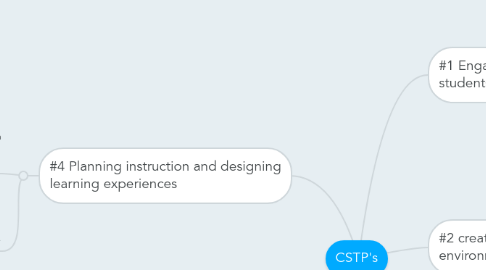CSTP's
Jennifer Harrisにより

1. #1 Engaging and supporting all students in learning
1.1. 1.3 Facilitating learning experiences that promote autonomy, interaction and choice - "oral activity participation" (2) Allowing students to engage in academic conversation with peer students is more effective than teacher oral delivery. Engaging in academic conversation increases the use of language and develops understanding. These activities provide ELL students to engage and interact with peer students while facilitating learning.
1.2. 1.1 Connecting student's prior knowledge, life experience, and interest with learning goals - "Using explicit cues" (68) This strategy can allow students to tap into their prior knowledge. One example would be having students recall prior knowledge to connect to the lesson. This can also inform the teacher of where each student is at. Supports ELL learners by allowing them to collect their prior knowledge and summarize it into spoken or written terms. Example KWL chart (69)
2. #2 creating and maintaining effective environments
2.1. 2.3 Promoting social development and group responsibility - "Include elements of both positive interdependence and individual accountability" (53) Keep students in a small group. Student's will need to understand that group activities are factored around the sink or swim concept. All students will need to participate and work together to in order to swim. This allows for ELL learners to facilitate in group learning while reinforcing language development
2.2. 2.5 Planning and implementing classroom procedures and routines that support student learning - "Develop and communicate a district or school homework policy." (119) By starting the class of with a written homework policy, all students and parents will understand the need for homework, the amount of homework given, and the consequences of not turning in an assignment. FOR ELL students, it is beneficial to have the homework policies listed in their native language for the student and for the parents. Working to involve parent's understanding of the homework policies could be beneficial for all students.
3. #3 Understanding and organizing subject matter
3.1. 3.4 Developing student understanding through instructional strategies that are appropriate to the subject matter - "Asking Tiered Questions" (14) A strategy used by teachers in which questions asked are associated with a student's second language acquisition stage. This involves a teacher's understanding of the stages and knowledge of where each ELL student falls. For student progression, the teacher should start asking questions related to the students stage and progressively implement questions from the next level.
3.2. 3.2 Organizing curriculum to support student understanding of subject matter - "Teacher's need to understand students' stages of second language acquisition and support language development in addition to content knowledge." (13) This allows teachers the ability to work with each student's "zone of proximal development." A teacher can work in a student's zone of proximal development by providing support or by scaffolding language development. Using these techniques will strengthen academic learning.
4. #4 Planning instruction and designing learning experiences
4.1. 4.1 Drawing on and valuing students' backgrounds, interests, and developmental learning needs - "Provide praise that is specific and aligned with expected performance and behaviors" (47) An example of this would be providing an diverse ELL student with praise when they move up a stage in their language proficiency. It is also important to understand student's cultures. This will allow the teacher to be culturally sensitive when providing praise or feedback.
4.2. 4.5 Modifying instructional plans to adjust for student needs - "Use expository advance organizers" (76) This is when teachers introduce content in a concise, uncomplicated way in either written or verbal form. Teachers of ELL students need to use more devices than simply verbal communication. For ELL students visuals, eye contact, and hand gestures are all beneficial to student learning. Also, by keeping their language short and simple ELL learners will be able to grasp what is being said and what needs to be done.
5. #5 Assessing student learning
5.1. 5.3 Involving and guiding all students in assessing their own learning - "Engage students in the feedback process" (32) This is the reciprocal teaching method in which the students become the teacher. You can use this strategy to revise work. Students will be able to review a peer's written work which will give them the ability to input revisions upon their own work. Great method for ELL learners
5.2. 5.1 Establishing and communicating learning goals for all students - "Provide feedback that addresses what is correct and elaborates on what students need to do next" (31) Students need to have a clear understanding of the learning objectives. When working with ELL learners, it is necessary that feedback is relevant and comprehensible. Modeling correct grammar while not overemphasizing it is beneficial for all learners.


